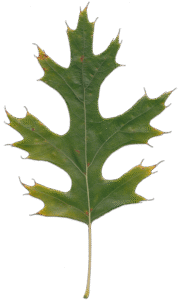Within the massive Quercus genus, oak species are subdivided into a number of sections, though all commercially harvested New World oaks can be placed into one of two categories: red oak, or white oak. This division is based on the morphology of the trees themselves—for instance, red oaks have pointed lobes on the leaves, while white oaks have rounded lobes.

Red oak leaf: pointed lobes
White oak leaf: rounded lobes
Quartersawn white oak: ray fleck pattern
But in addition to the leaves and outward appearance of the trees, the wood of the various oaks also have a few important distinctions. Most notably, white oak is rot resistant, while red oak is not—an important detail for boatbuilding and exterior construction projects. White oak also has a unique ray fleck pattern when perfectly quartersawn that’s seen more often in antiques—a figure that’s sometimes called “tiger oak” in antique furniture circles.
It should be noted that red oak also has conspicuous ray fleck patterns on its quartersawn surfaces, but it’s generally just not quite of the same caliber and size as white oak. (See this quartersawn picture of red oak for reference.)
Oak lumber: Superficial color differences
While there is one specific wood species (Quercus alba) that’s commonly considered the “white oak,” and there is one specific species (Quercus rubra) that’s considered the “red oak,” when you buy oak lumber within North America, oftentimes you will not actually be buying these two exact species, but instead you may be buying one of the oaks contained within the two broad red and white groupings. Basically, you’re buying characteristics found in an oak group, and not necessarily an exact species. For the rest of this article, I’ll be referring to red oaks and white oaks (plural) as two different groups of trees, and not simply as individual species.
At a casual glance, unfinished oak lumber will generally be light brown, either with a slight reddish cast (usually red oak), or a subtle olive-colored cast (white oak). However, there are abnormally light or dark outliers and pieces that are ambiguously colored, making separation based on color alone unreliable—this is especially true if the wood is finished and/or stained.
Nonetheless, it can be helpful to get a baseline view of the typical color that’s seen in red and white oaks. Listed below are small thumbnails of various oak species in their raw unfinished form, arranged in either the red or white oak grouping. Comparing the two groups is simultaneously helpful and also confusing. You’ll notice that there’s a general categorization of color that most samples fall into (helpful), but you’ll see that there’s also no hard and fast rule to easily tell the two groups apart by color (that’s the confusing part).
Red oak group
Red oak (Quercus rubra)
Black oak (Quercus velutina)
California black oak (Quercus kelloggii)
Cherrybark oak (Quercus pagoda)
Laurel oak (Quercus laurifolia)
Pin oak (Quercus palustris)
Scarlet oak (Quercus coccinea)
Shumard oak (Quercus shumardii)
Southern red oak (Quercus falcata)
Water oak (Quercus nigra)
Willow oak (Quercus phellos)